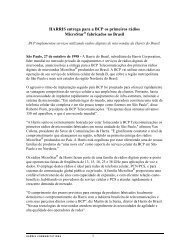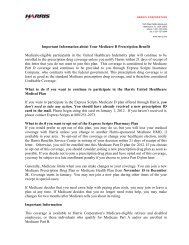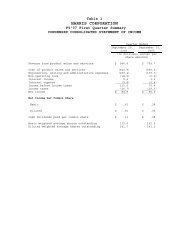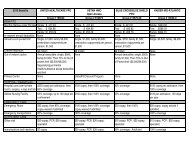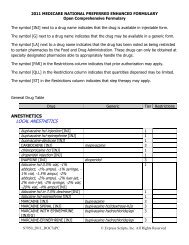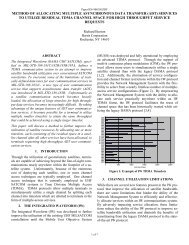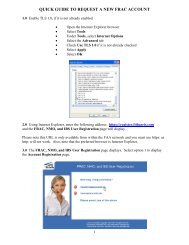harris corporation
harris corporation
harris corporation
You also want an ePaper? Increase the reach of your titles
YUMPU automatically turns print PDFs into web optimized ePapers that Google loves.
NOTES TO CONSOLIDATED FINANCIAL STATEMENTS (Continued)<br />
rent, rent concessions, leasehold improvement incentives or unusual provisions or conditions. We do not consider<br />
any of these individual leases material to our operations. Leasehold improvements made either at the inception of<br />
the lease or during the lease term are amortized over the current lease term, or estimated life, if shorter.<br />
NOTE 19: DERIVATIVE INSTRUMENTS AND HEDGING ACTIVITIES<br />
In the normal course of doing business, we are exposed to global market risks, including the effect of changes<br />
in foreign currency exchange rates. We use derivative instruments to manage our exposure to such risks and<br />
formally document all relationships between hedging instruments and hedged items, as well as the risk-management<br />
objective and strategy for undertaking hedge transactions. We recognize all derivatives in our Consolidated Balance<br />
Sheet at fair value. We do not hold or issue derivatives for trading purposes.<br />
At July 1, 2011, we had open foreign currency forward contracts with a notional amount of $83.9 million, of<br />
which $30.2 million were classified as fair value hedges and $53.7 million were classified as cash flow hedges. This<br />
compares with open foreign currency forward contracts with a notional amount of $46.5 million at July 2, 2010, of<br />
which $30.3 million were classified as fair value hedges and $16.2 million were classified as cash flow hedges. At<br />
July 1, 2011, contract expiration dates ranged from less than 1 month to 33 months with a weighted average<br />
contract life of 9 months.<br />
Balance Sheet Hedges<br />
To manage the exposure in our balance sheet to risks from changes in foreign currency exchange rates, we<br />
implement fair value hedges. More specifically, we use foreign currency forward contracts and options to hedge<br />
certain balance sheet items, including foreign currency denominated accounts receivable and inventory. Changes in<br />
the value of the derivatives and the related hedged items are reflected in earnings, in the “Cost of product sales” line<br />
item in our Consolidated Statement of Income. As of July 1, 2011, we had outstanding foreign currency forward<br />
contracts denominated in the Euro, British Pound, Canadian Dollar and Australian Dollar to hedge certain balance<br />
sheet items. The net gains or losses on foreign currency forward contracts designated as fair value hedges were not<br />
material in fiscal 2011, 2010 or 2009. In addition, no amounts were recognized in earnings in fiscal 2011, 2010 and<br />
2009 related to hedged firm commitments that no longer qualify as fair value hedges.<br />
Cash Flow Hedges<br />
To manage our exposure to currency risk and market fluctuation risk associated with anticipated cash flows that<br />
are probable of occurring in the future, we implement cash flow hedges. More specifically, we use foreign currency<br />
forward contracts and options to hedge off-balance sheet future foreign currency commitments, including purchase<br />
commitments from suppliers, future committed sales to customers and intercompany transactions. These derivatives<br />
are primarily being used to hedge currency exposures from cash flows anticipated in our RF Communications<br />
segment related to programs in the United Kingdom and Canada. We also have hedged U.S. dollar payments to<br />
suppliers to maintain our anticipated profit margins in our international operations. As of July 1, 2011, we had<br />
outstanding foreign currency forward contracts denominated in the British Pound and Canadian Dollar to hedge<br />
certain forecasted transactions.<br />
These derivatives have only nominal intrinsic value at the time of purchase and have a high degree of<br />
correlation to the anticipated cash flows they are designated to hedge. Hedge effectiveness is determined by the<br />
correlation of the anticipated cash flows and the maturity dates of the derivatives used to hedge these cash flows.<br />
These financial instruments are marked-to-market using forward prices and fair value quotes with the offset to other<br />
comprehensive income, net of hedge ineffectiveness. Gains and losses from other comprehensive income are<br />
reclassified to earnings when the related hedged item is recognized in earnings. The ineffective portion of a<br />
derivative’s change in fair value is immediately recognized in earnings. The cash flow impact of our derivatives is<br />
included in the same category in our Consolidated Statement of Cash Flows as the cash flows of the item being<br />
hedged.<br />
The amount of gains or losses from cash flow hedges recognized in earnings or recorded in other<br />
comprehensive income, including gains or losses related to hedge ineffectiveness, was not material in fiscal 2011,<br />
2010 or 2009. We do not expect the amount of gains or losses recognized in the “Accumulated other comprehensive<br />
income (loss)” line item in our Consolidated Balance Sheet as of July 1, 2011 that will be reclassified to earnings<br />
from other comprehensive income within the next 12 months to be material.<br />
86




